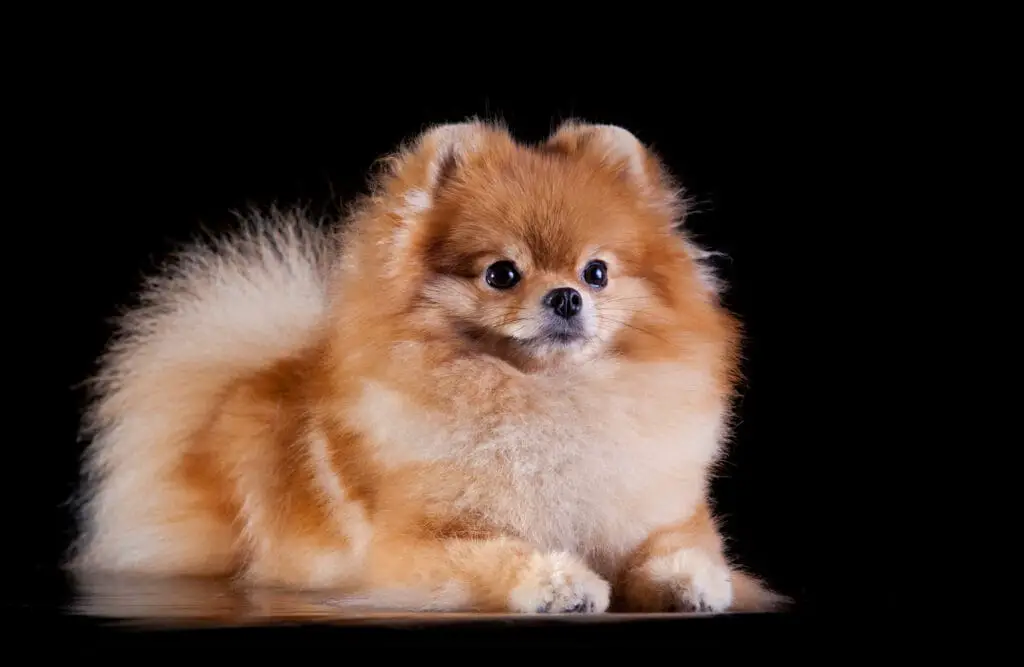Our website is supported by our users. We sometimes earn money when you click an affiliate link and make a purchase. This is at no extra cost to you and helps us to create quality content. Thank you for your support. For all that have shown us such wonderful support, we thank you from the bottom of our hearts!
The Pomeranian is a captivating toy breed known for its fluffy coat and lively personality.
Originating from the Pomerania region of Central Europe, these small dogs have become one of the most popular dog breeds for their compact size and endearing disposition.
With a heritage tracing back to large sled-pulling dogs, the Pomeranian has adapted over years to become a cherished companion in homes worldwide.

As one of the toy breeds, Poms possess a bold and confident temperament, often unaware of their size when confronting larger breeds of dog, animals or new environments.
Their intelligence and eagerness to learn make them highly trainable, provided they receive consistent and positive reinforcement.
Owners appreciate this tiny dog not only for their sociable nature but also for the relatively straightforward grooming needs, despite the appearance of their luxurious, long coat.
When considering adding a Pommie to your life, it’s essential to be aware of their specific needs, from daily mental stimulation to regular health check-ups to mitigate common breed-related health issues.
While their abundant energy and playful antics are sure to bring joy, they thrive best with attentive care and a loving environment.
Key Takeaways
- Poms are small, affectionate dogs with a rich heritage.
- They exhibit a confident demeanor and are easily trainable.
- Proper care includes mental stimulation and maintaining their health and coat.
History of the Pomeranian
The Pomeranian dog is rooted in a rich lineage originating from Arctic sled-pulling breeds.
Poms belong to the Spitz family of dogs.
Originating from the Arctic region, Spitz-type dogs were bred for various purposes, including herding, hunting, and companionship.
Over time, as these dogs spread to different regions, they adapted to local environments and developed into distinct breeds.
The Pomeranian, originating from the larger sled-pulling Spitz dogs in the Pomerania region (now part of Poland and Germany), was selectively bred for a smaller size and distinctive appearance evolving into the small companion dogs you’re familiar with today.
In the 18th century, Pomeranians gained notable prominence through royal influence.
When Queen Charlotte brought Pommies to England, the breed’s evolution took a significant turn.
Her dogs, named Phebe and Mercury, became immortalized in portraits by the esteemed painter Sir Thomas Gainsborough.
This royal affinity escalated when Queen Victoria chose to own a Pommie, leading to a widespread preference for the smaller variants of the breed.
By the end of Queen Victoria’s life, the breed’s overall size had halved, cementing the Pom’s status as a beloved toy breed.
Your Pomeranian’s legacy doesn’t stop with royalties; they have also been muses to some of history’s greatest creatives.
They inspired pieces by Mozart and even Chopin, who composed a piece whimsically capturing a Pom’s playful tail-chasing.
Also, there are rumors that a cherished Pomeranian is said to have sat on a satin cushion beneath Michelangelo as he painted the ceiling of the Sistine Chapel.
While filming the famous film “The Titanic” James Cameron purposefully assigned elderly Rose a Pommie since Margaret Hays’s Pomeranian, “Bebe,” was one of just three canines known to have survived the sinking of the Titanic disaster.
As a Pommie owner, you’re part of a story that has been unfurling for centuries.
Cherish the heritage and the journey that has made your Pomeranian what it is today – a small, sturdy, and lively companion with a history as fascinating as its expressive, bright-eyed demeanor.
Physical Characteristics
The Pomeranian breed is distinguished by its small size, almond-shaped eyes vibrant personality, and fluffy, double coat. Here you’ll find specifics on their dimensions, coat, and general appearance.
Height Male
Typically, males stand between 6 to 7 inches tall at the shoulder.
Height Female
Females are generally within the same height range as males, standing about 6 to 7 inches tall.
Weight Male
A male usually weighs in the range of 3 to 7 pounds.
Weight Female
A female will similarly weigh between 3 to 7 pounds, depending on her diet and overall health.
Eye Colors
Their eyes are typically dark and almond-shaped, giving them an alert and intelligent expression.
Eye colors range primarily in shades of brown, but some Poms might have slightly lighter hues.
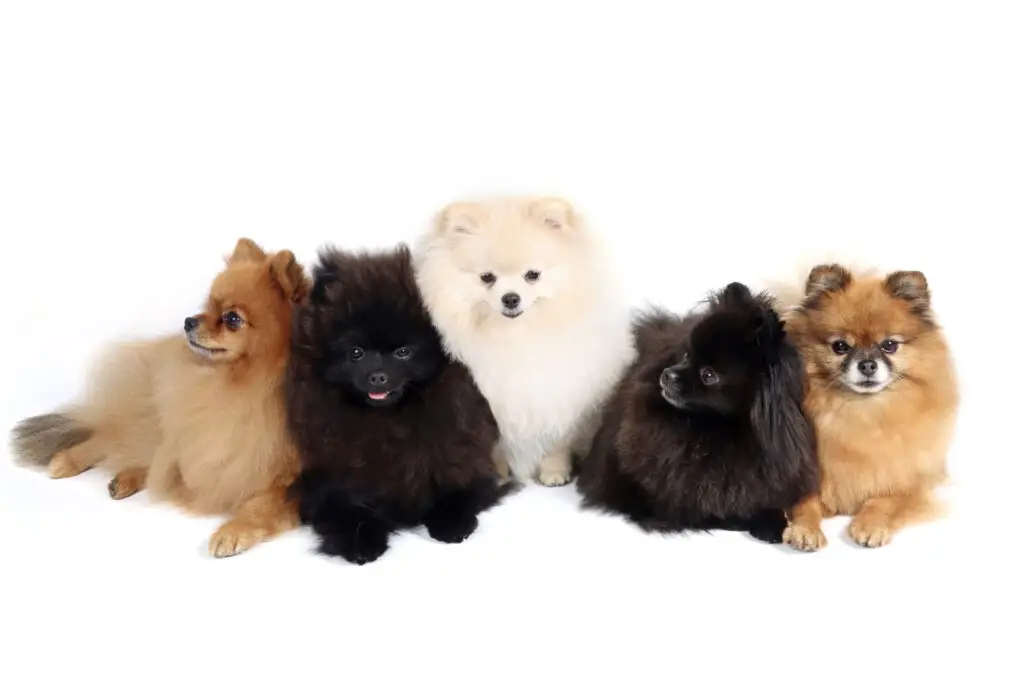
Coat Colors
They are known for a spectrum of coat colors such as red, orange, cream, sable, black, brown, and blue, with numerous patterns and combinations.
Coat Types
The Pomeranian boasts a luxurious double coat with a fluffy undercoat and a longer topcoat that forms a ruff of fur around their neck, which is particularly prominent in males.
Life Expectancy
With proper care, Pommies have a life expectancy ranging from 12 to 16 years, making them long-lived companions for their size.
Overview of the Physical Characteristics of the Pomeranian
Your Pommie’s fox-like face and plumed curly tail are iconic features of this toy breed.
Despite their diminutive stature, they have a bold and curious nature, reflected in their sturdy build and confident demeanor.
Temperament & Training
Temperament: Pomeranians are known for their playful and affectionate nature, often making them excellent family pets.
They are intelligent, lively, and outgoing, which contributes to their charm.
Alongside these traits, they can be quite independent, yet they remain loyal and affectionate towards their owners.
They are best with older children as young children may see them as a toy and engage in rough play where tiny Pomeranians could be injured.
The are a great companion to older people because they are lightweight, don’t require a lot of exercise and fit easily into apartment living.
Key Personality Traits:
- Playful & energetic
- Loyal & loving
- Independent but affectionate
- Intelligent & alert
When it comes to training, their intelligence means that Pomeranians are typically quick learners.
Training should be started early and it’s important to be consistent and patient.
They respond well to positive reinforcement techniques such as praise or treats.
Training Tips:
- Start training early.
- Be consistent with commands and routines.
- Use positive reinforcement.
- Keep sessions short and engaging.
Pomeranians may have a tendency to bark, so it may be beneficial to include bark control in their training.
They also have a lot of energy for small dogs, which can be channeled through agility or trick training to keep them both physically and mentally stimulated.
While they are affectionate, they may not always interact well with very small children, so it’s crucial to supervise early interactions and educate children on how to properly handle these small dogs.
Remember that temperament can vary, and socialization is key to fostering a well-adjusted dog.
To learn more about their tendency to bark or grooming needs, review what the American Kennel Club has to say.
For further advice on training techniques, take a look at the guidance from Pomeranian Headquarters.
Health Issues of the Pomeranian
Pomeranians are generally lively and robust little dogs, but like all breeds, they are prone to certain health issues.
As a Pomeranian owner, being informed about these potential health problems can help you to take proactive steps to ensure your pet’s well-being.
Tracheal Collapse
This condition is identified by a weakening of the tracheal rings in the dog’s windpipe, causing a chronic, dry cough.
Dental Issues
Your Pomeranian may be susceptible to gum diseases and tooth loss, so regular dental hygiene and professional care is vital. In severe cases, they may have to have teeth removed.
Joint Problems
- Luxating patella, a condition where the kneecap dislocates from its normal position.
- Hip Dysplasia, which can lead to arthritis or mobility problems.
Skin and Coat Health
- Alopecia X, also known as Black Skin Disease, can cause hair loss and may affect your dog’s appearance and skin health.
- Severe Hair Loss Syndrome, another condition leading to hair thinning or baldness.
Eye Conditions
Cataracts or tear duct problems could affect your dog’s vision, necessitating veterinary attention.
Cardiac Issues
Heart conditions such as murmurs or valve disease could also manifest, making regular veterinary check-ups crucial.
Endocrine Disorders
- Hypothyroidism, where the thyroid gland doesn’t produce enough hormones.
- Cushing’s Disease, which can result from the body’s overproduction of cortisol.
Lastly, Pomeranians can experience epilepsy, which leads to seizures that vary in severity. It’s essential to have your vet assess any signs of seizures immediately.
Grooming Your Pomeranian
Proper grooming is essential for your Pomeranian’s health and appearance.
Regular grooming sessions help maintain their fluffy coat, prevent skin issues, and keep them comfortable.
Brushing
Frequency: Brush your Pomeranian at least three times a week. During shedding seasons, increase this to daily brushing to manage their dense undercoat.
Tools: Utilize a bristle brush or a wire pin brush. A proper grooming comb can help detangle fur without causing discomfort.
Bathing
How often: Bathe your Pomeranian once a month in winter, and more frequently in summer or if they get particularly dirty.
Shampoo: Always use a gentle dog shampoo that won’t strip their natural oils. As Poms get older, they may get dry, itchy skin underneath all that fur so a shampoo formulated for itchy skin may be in order.
We really like this ELEGX massager. It is great for getting down to your dog’s skin with the shampoo.
Cutting Fur/Hair
Trimming needs: Your Pomeranian’s coat needs trimming around their paws and rear end to maintain hygiene and mobility.
Professional help: While trimming can be done at home, you may prefer to seek services for an expert touch.
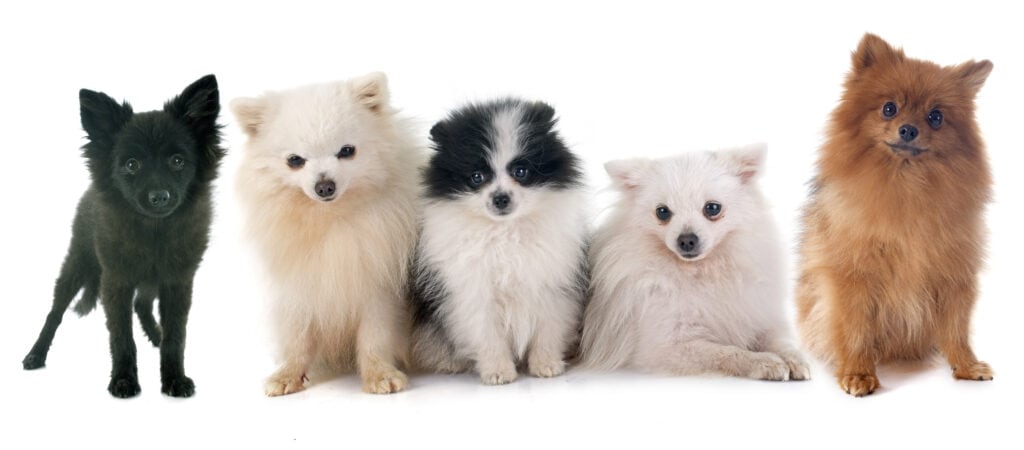
Clipping or Grinding Nails
Frequency: Check their nails once a month. Long nails can cause discomfort or even pain for your pet.
Tools: Use dedicated dog nail clippers or a grinder designed for small dogs.
If you cut their quick, dip their nails in Styptic Powder.
If you need more information on trimming down your dog’s nails, check out our articles on How to Grind Your Dog’s Nails or How to Clip Your Dog’s Nails Safely.
Dental Care
Tooth brushing: Brush their teeth two or three times a week to prevent dental disease and bad breath.
Supplies: Use a dog-specific toothbrush made for a smaller mouths and dog toothpaste; human products are not suitable for your Pomeranian.
If you can’t quite get a toothbrush into their small mouths, try these finger wipes.
Cleaning Ears
Checking and cleaning: Inspect your Pomeranian’s ears weekly for wax build-up or signs of infection.
Products: Clean their ears with a vet-approved ear cleaner and cotton balls or pads—never use cotton swabs deep inside the ear canal.
We like these Pet MD – Dog Ear Cleaner Wipes – Otic Cleanser for Dogs.
Owning a Pomeranian
Owning a Pomeranian is a delightful experience that comes with specific financial responsibilities and considerations to ensure the well-being of your fluffy companion.
Cost of Purchase
The purchase price for a Pomeranian varies widely based on factors like lineage, location, and breeder reputation.
You can expect to pay anywhere from $500 to $6000.
If you’re looking for a show-quality puppy with distinguished pedigree, prices can be at the higher end of this range. It’s important to allocate a budget for this initial cost.
Maintenance Costs (Special Training, Medical Costs, Grooming)
Beyond the purchase, Pomeranians incur ongoing costs:
- Special Training: Socialization and obedience training costs can range from $50 to $200 for group sessions. Private lessons can be substantially more.
- Medical Costs: Routine veterinary care, including vaccinations and check-ups, can cost approximately $500 to $1000 annually.
- Emergency medical expenses can significantly increase this.
- Grooming: Pomeranians have a thick double coat which requires regular grooming.
- Professional grooming sessions can cost $30 to $500 yearly, depending on frequency and services.
Adopting a Pomeranian
Adoption is a cost-effective and compassionate option.
Adoption fees typically range from $100 to $300, which usually includes spaying/neutering, vaccinations, and microchipping.
By adopting, you also provide a home to a Pomeranian that may otherwise go without.
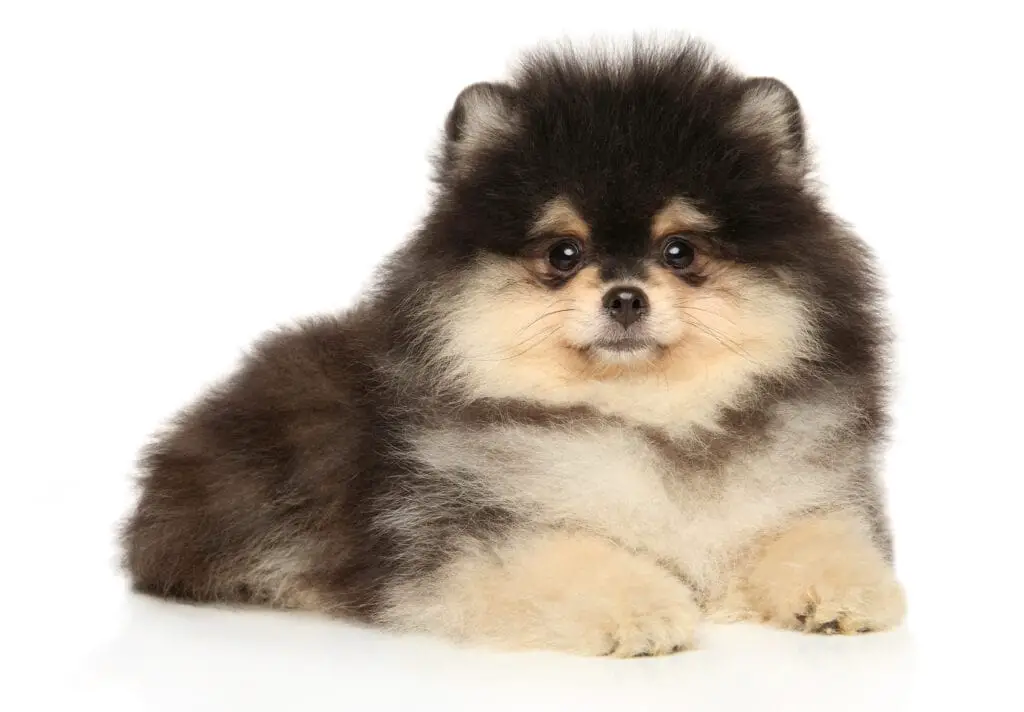
Finding Reputable Breeders
Look for a reputable breeder who prioritize health and temperament and provide health clearances to get you the right puppy.
Here are some steps to ensure responsible breeding practices:
- Research extensively.
- Visit the breeder in person if possible.
- Check references and reviews.
- Expect breeders to ask you questions too; this indicates they care about where their Pomeranian puppies are going.
Frequently Asked Questions
In this section, you’ll find precise answers to some of the most common questions about Pomeranians.
From their lifespan and weight to their traits and suitability for apartment living, get your queries addressed here.
What is the average lifespan of a Spitz breed, such as the Pomeranian?
Pomeranians, a member of the Spitz breed, typically live between 12 to 16 years. Proper care can influence their lifespan positively.
How much does a typical Pomeranian weigh?
A healthy adult Pomeranian generally weighs between 3 to 7 pounds, reflecting their categorization as a toy breed.
What are the characteristics of a white Pomeranian?
White Pomeranians are known for their alluring, fluffy white coats. Despite the color, they share the breed’s friendly personality and small stature.
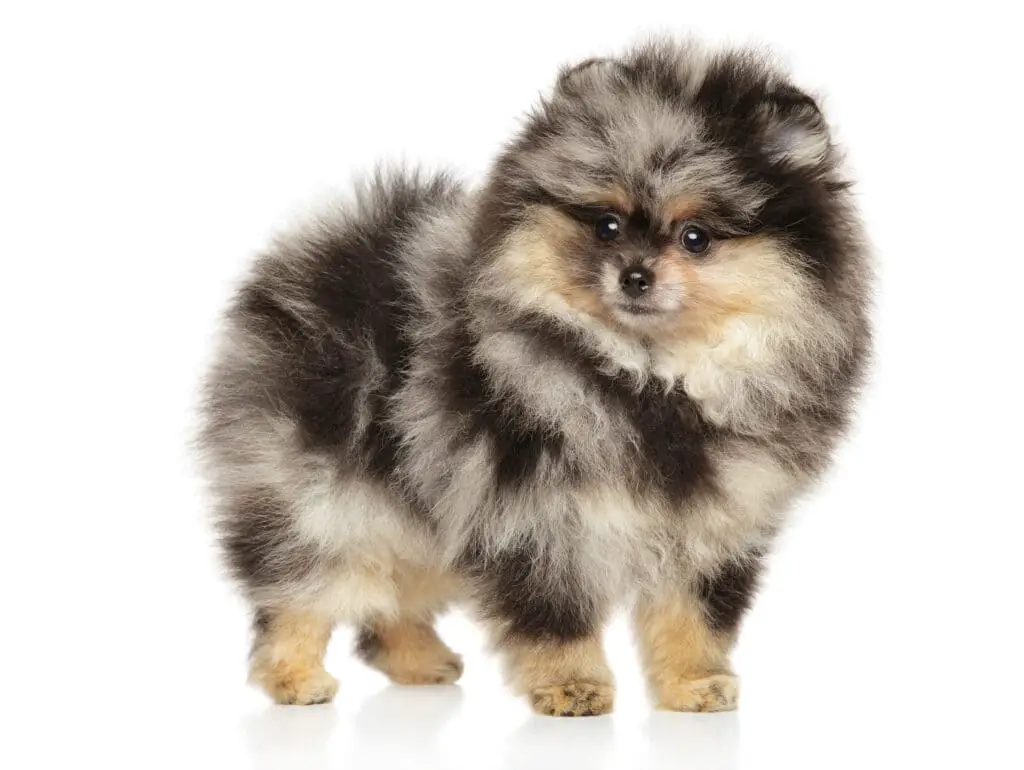
Can Pomeranians be considered suitable pets for apartment living?
Yes, Pomeranians are suitable for apartment living due to their small size and adaptability, but they require regular exercise and mental stimulation.
What factors contribute to the higher price point of Pomeranians?
The price of Pomeranians is influenced by factors such as pedigree, coat color, breeder reputation, and the cost of breed-specific care.
Is it common for Pomeranians to bark frequently, and how can this be managed?
Pomeranians do have a tendency to bark, which can be managed through consistent training and providing adequate mental and physical stimulation.
Conclusion: Bottom Line on the Pomeranian

When considering a Pomeranian as your companion, appreciate that you’re choosing a dog with a bold and spirited personality packed into a petite frame.
Your adorable Pomeranian will be adorned with a luxurious double coat that requires regular grooming to maintain its health and appearance.
Key Factors to Remember:
- Size: Ideal for smaller living spaces
- Exercise Needs: Moderately active; enjoys walks and play
- Grooming: Every 3-4 weeks to keep their coat in top condition
You’ll find in these dogs a blend of curiosity, playfulness, and intelligence that makes them a delightful family member.
However, don’t underestimate the importance of consistent training to ensure well-mannered behavior.
Health Awareness:
- Regular vet check-ups are crucial
- Be attuned to dental and weight issues
As you acclimate your Pomeranian to your home, keep in mind their ancestral background hints at a surprisingly robust and athletic nature, meaning they’re more than just their size.
They’ll thrive with affection and may exhibit a protective streak despite their small figure.
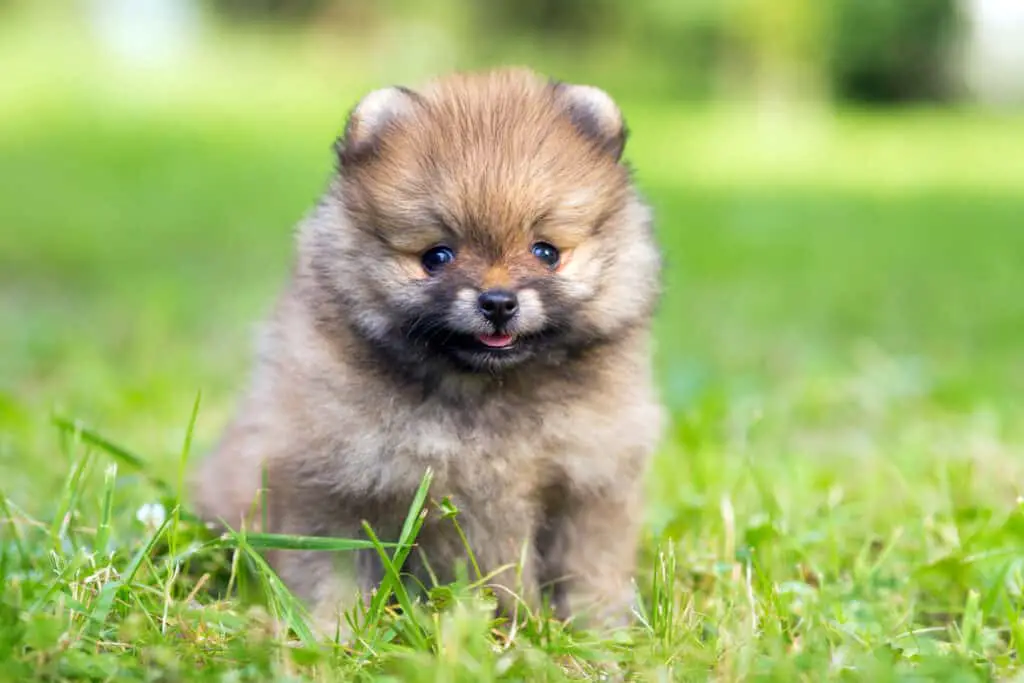
Social Considerations:
- Early socialization helps with friendliness
- May be cautious or bark at strangers
- Unsurprisingly good as a watchdog due to alertness and vocal nature
Your commitment to caring for a Pomeranian should be seen as a long-term endeavor that’s rewarded with unwavering companionship.
Cherish and nurture your little friend, and they’ll surely enrich your life with their unassuming charisma and vivacious spirit.
Please read our Legal Disclaimer

